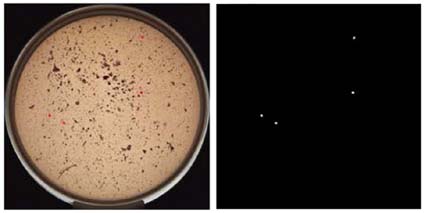4 colonies are detected among many hamburger pieces !



Set poured plates and start a test !
Hamburger purchased from a supermarket was stomached, but not filtered, and then the sample liquid was used as dilution liquid to prepare E. coli sample.
Four colonies of E. coli were detected and counted precisely on 10^0 diluted sample of about 400 beef fragment pieces.
Reviewing the saved plate image data in chronological order, going back in time, it was verified that four colonies counted by MicroBio µ3D system was correct count.
The four colonies of E. coli detected at 11hr of incubation.

Image of desoxycholate agar media plate at 24hr and colony count markesrs
Related Page
- [Wide Colony Count Range]
Range of automated colony count is from 1 to about 10 thousand. - MicroBio µ3D has a wide count range and counts from 1 colony to closer to 10 thousands.
- [Colony Count Graph]
When two species are detected in a test sample, the colony count becomes staircase. - When two species are detected in a test sample, the colony detection and count graph of MicroBio µ3D becomes staircase.
- [Rapid Detection and Count]
They are the results that show how MicroBio µ3D system detect and counts micro-colonies rapidly and automatically. - These are the performance results of automated rapid detection and count of MicroBio µ3D on E. coli, Aspergillus brasiliensis and Candida albicans. Detection is in real time.
- [Colony Count Unit]
A cluster of touched colonies is counted correctly as separated colonies. - CFU (Colony Forming Unit) has been used for counting microbial colonies as the unit. Using MicroBio µ3D system, the exact number can be used for counting colonies.
- [Invisible colonies detected]
Colonies under a piece of hamburger is detected. - MicroBio µ3D detects invisible colonies under a piece ot hamburger. The colonies become visible after a prolonged incubation, coming out from the rim of a meat piece.
